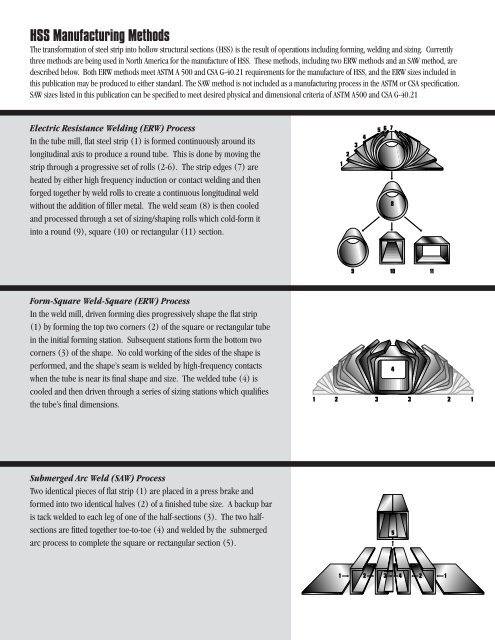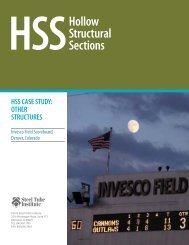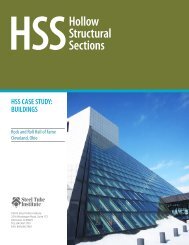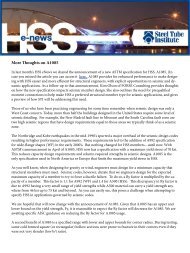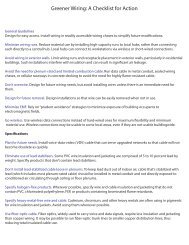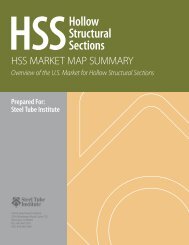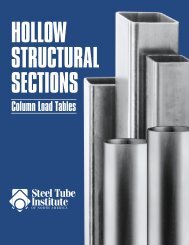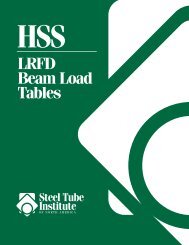Metric Dimensions and Sections Properties - the Steel Tube Institute
Metric Dimensions and Sections Properties - the Steel Tube Institute
Metric Dimensions and Sections Properties - the Steel Tube Institute
Create successful ePaper yourself
Turn your PDF publications into a flip-book with our unique Google optimized e-Paper software.
HSS Manufacturing Methods<br />
The transformation of steel strip into hollow structural sections (HSS) is <strong>the</strong> result of operations including forming, welding <strong>and</strong> sizing. Currently<br />
three methods are being used in North America for <strong>the</strong> manufacture of HSS. These methods, including two ERW methods <strong>and</strong> an SAW method, are<br />
described below. Both ERW methods meet ASTM A 500 <strong>and</strong> CSA G-40.21 requirements for <strong>the</strong> manufacture of HSS, <strong>and</strong> <strong>the</strong> ERW sizes included in<br />
this publication may be produced to ei<strong>the</strong>r st<strong>and</strong>ard. The SAW method is not included as a manufacturing process in <strong>the</strong> ASTM or CSA specification.<br />
SAW sizes listed in this publication can be specified to meet desired physical <strong>and</strong> dimensional criteria of ASTM A500 <strong>and</strong> CSA G-40.21<br />
Electric Resistance Welding (ERW) Process<br />
In <strong>the</strong> tube mill, flat steel strip (1) is formed continuously around its<br />
longitudinal axis to produce a round tube. This is done by moving <strong>the</strong><br />
strip through a progressive set of rolls (2-6). The strip edges (7) are<br />
heated by ei<strong>the</strong>r high frequency induction or contact welding <strong>and</strong> <strong>the</strong>n<br />
forged toge<strong>the</strong>r by weld rolls to create a continuous longitudinal weld<br />
without <strong>the</strong> addition of filler metal. The weld seam (8) is <strong>the</strong>n cooled<br />
<strong>and</strong> processed through a set of sizing/shaping rolls which cold-form it<br />
into a round (9), square (10) or rectangular (11) section.<br />
Form-Square Weld-Square (ERW) Process<br />
In <strong>the</strong> weld mill, driven forming dies progressively shape <strong>the</strong> flat strip<br />
(1) by forming <strong>the</strong> top two corners (2) of <strong>the</strong> square or rectangular tube<br />
in <strong>the</strong> initial forming station. Subsequent stations form <strong>the</strong> bottom two<br />
corners (3) of <strong>the</strong> shape. No cold working of <strong>the</strong> sides of <strong>the</strong> shape is<br />
performed, <strong>and</strong> <strong>the</strong> shape’s seam is welded by high-frequency contacts<br />
when <strong>the</strong> tube is near its final shape <strong>and</strong> size. The welded tube (4) is<br />
cooled <strong>and</strong> <strong>the</strong>n driven through a series of sizing stations which qualifies<br />
<strong>the</strong> tube’s final dimensions.<br />
Submerged Arc Weld (SAW) Process<br />
Two identical pieces of flat strip (1) are placed in a press brake <strong>and</strong><br />
formed into two identical halves (2) of a finished tube size. A backup bar<br />
is tack welded to each leg of one of <strong>the</strong> half-sections (3). The two halfsections<br />
are fitted toge<strong>the</strong>r toe-to-toe (4) <strong>and</strong> welded by <strong>the</strong> submerged<br />
arc process to complete <strong>the</strong> square or rectangular section (5).<br />
1<br />
2<br />
3<br />
4<br />
5 6 7<br />
8<br />
9 10 11<br />
4<br />
1 2 3 3<br />
2<br />
1<br />
1 2 3 4<br />
5<br />
2 1


